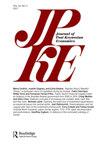技术与生产力:对综合指标的批判
IF 1
3区 经济学
Q4 ECONOMICS
引用次数: 0
摘要
摘要经济分析师利用全要素生产率的趋势来评估经济体利用技术进步的有效性。然而,这项措施在几个不同的方面都存在问题。首先,有可能将劳动力、资本和技术对经济产出的相对贡献分开的想法需要忽略它们在实际生产中的复杂相互依存关系。其次,由于近几十年来所有发达市场社会的全要素生产率增长都有所下降,因此有充分的理由相信,这种下降是与紧缩政策有关的经济增长率放缓的产物。第三,对全要素生产率的依赖假设国内生产总值的衡量标准准确地反映了经济产出的变化,即使生产有形商品的劳动力比例大幅下降。最后,还有其他指标表明,目前的技术进步速度可能与前几十年一样强劲或更强。本文章由计算机程序翻译,如有差异,请以英文原文为准。
Technology and productivity: a critique of aggregate indicators
Abstract Economic analysts have used trends in total factor productivity (TFP) to evaluate the effectiveness with which economies are utilizing advances in technology. However, this measure is problematic on several different dimensions. First, the idea that it is possible to separate out the relative contribution to economic output of labor, capital, and technology requires ignoring their complex interdependence in actual production. Second, since TFP growth has declined in recent decades in all of the developed market societies, there is good reason to believe that the decline is an artifact of the slower rates of economic growth that are linked to austerity policies. Third, reliance on TFP assumes that measures of the gross domestic product are accurately capturing changes in economic output, even as the portion of the labor force producing tangible goods has declined substantially. Finally, there are other indicators that suggest that current rates of technological progress might be as strong or stronger than in earlier decades.
求助全文
通过发布文献求助,成功后即可免费获取论文全文。
去求助
来源期刊

Journal of Post Keynesian Economics
ECONOMICS-
CiteScore
1.70
自引率
10.00%
发文量
23
期刊介绍:
The Journal of Post Keynesian Economics is a scholarly journal of innovative theoretical and empirical work that sheds fresh light on contemporary economic problems. It is committed to the principle that cumulative development of economic theory is only possible when the theory is continuously subjected to scrutiny in terms of its ability both to explain the real world and to provide a reliable guide to public policy.
 求助内容:
求助内容: 应助结果提醒方式:
应助结果提醒方式:


